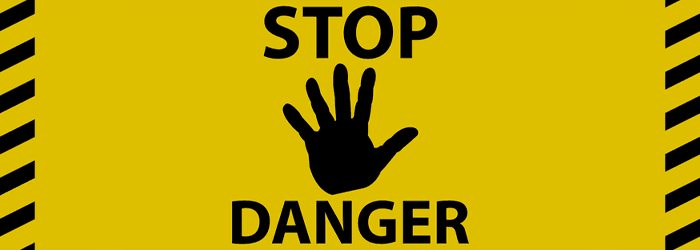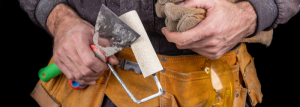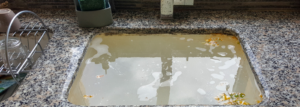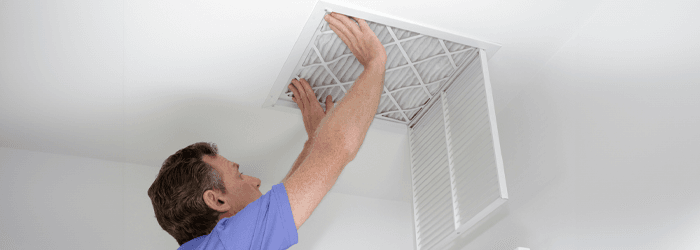Follow The EPA’s Guidelines
With the inventory of resale homes on the market at a low and the inflated costs of buying one still rising, many homeowners are choosing to remodel rather than sell and buy a new home. A remodel can make your home feel brand new. At Rosie on the House, we love remodeling!
However, there are a couple of issues that you must be mindful of – asbestos and lead.
We’ve discussed lead and asbestos before; because they are so important, we are talking about them again, especially now as remodeling projects have been on the rise and will continue to do so.
Asbestos
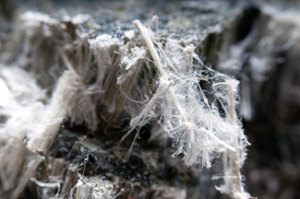 Asbestos is mineral fiber that was added to a variety of products to strengthen them and provide heat insulation and fire resistance. The Environmental Protection Agency (EPA) tells us that it can be found in:
Asbestos is mineral fiber that was added to a variety of products to strengthen them and provide heat insulation and fire resistance. The Environmental Protection Agency (EPA) tells us that it can be found in:
- insulation
- roofing and siding shingles
- ceiling tiles
- vinyl floor tiles
- backing on vinyl sheet flooring and adhesives
- paper products
- cement products
- textured paint and patching compounds
- walls and floors around wood-burning stoves
- hot water and steam pipes coated with an asbestos material or covered with an asbestos blanket or tape
Unless it is labeled, it is nearly impossible to tell whether a material contains asbestos simply by looking at it. It can be positively identified only with a special type of microscope.
Houses built between 1930 and 1950 may have asbestos as insulation. It may be present in textured paint and in patching compounds used on wall and ceiling joints. Their use was banned in 1977.
According to the Arizona Department of Environmental Quality (ADEQ) , asbestos is a proven carcinogen. The inhalation of these microscopic fibers can cause serious health problems. Exposure increases the risk of developing lung cancer, mesothelioma (a rare form of cancer that develops in the protective lining of various organs) or asbestosis (a scarring of the lungs). Symptoms of such asbestos-related diseases may take 15 to 30 years to develop after initial exposure. Asbestos has since been phased out of commercial use due to its link to health problems.
 Maricopa County Air Quality Department and the Pima County Department of Environmental Quality it is usually best to leave asbestos that is in good condition alone. Generally, material that is in good condition will not release asbestos fibers. However, if removal is necessary, have your home inspected by a trained and accredited asbestos professional. Do not take samples yourself.
Maricopa County Air Quality Department and the Pima County Department of Environmental Quality it is usually best to leave asbestos that is in good condition alone. Generally, material that is in good condition will not release asbestos fibers. However, if removal is necessary, have your home inspected by a trained and accredited asbestos professional. Do not take samples yourself.
Check material regularly if you suspect it may contain asbestos. Don’t touch it but look for signs of wear or damage such as tears, abrasions, or water damage. Damaged material may release asbestos fibers. This is particularly true if you often disturb it by hitting, rubbing, or handling it, or if it is exposed to extreme vibration or air flow.
Sometimes, the best way to deal with slightly damaged material is to limit access to the area and not touch or disturb it. Discard damaged or worn asbestos gloves, stove-top pads, or ironing board covers in accordance with local and federal laws. Check with local health, environmental, or other appropriate officials to find out proper handling and disposal procedures.
If asbestos material is more than slightly damaged, or if you are going to make changes in your home that might disturb it, repair or removal by a professional is needed. Before you have your house remodeled, find out whether asbestos materials are present.
Click Here for a list of dos and don’ts when dealing with asbestos.
Visit the Arizona Department of Environmental Quality (ADEQ) regarding asbestos regulations in Arizona. Learn more about asbestos at the Asbestos National Emission Standard for Hazardous Air Pollutants (NESHAP).
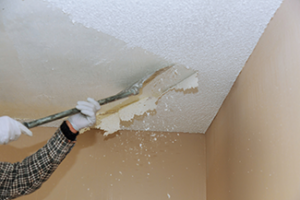 A Note About Popcorn Ceilings
A Note About Popcorn Ceilings
Homes built before 1978 that have popcorn ceilings could contain asbestos. Asbestos-containing materials may release fibers when they are disturbed, damaged, removed improperly, repaired, cut, torn, sanded, sawed, drilled, or scraped. If you are determined to remove a popcorn ceiling or chip paint yourself, which Rosie highly advises against, Click Here for a list of safeguards outlined by the EPA.
Lead Paint
If your home was built before 1978, lead paint may have been used during the building of your house.
Common renovation, repair, and painting activities like sanding, cutting, chipping, and replacing windows, can disturb lead-based paint and asbestos creating hazardous lead dust and chips which can be harmful to adults, children, and pets.
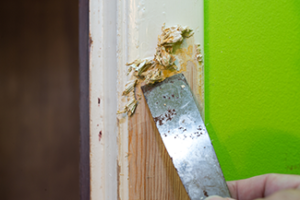 The EPA notes that lead-based paint may also be a hazard when found on surfaces that children can chew or that get a lot of wear-and-tear, such as:
The EPA notes that lead-based paint may also be a hazard when found on surfaces that children can chew or that get a lot of wear-and-tear, such as:
- Windows and windowsills
- Doors and door frames
- Stairs, railings, banisters, and porches.
The EPA’s Renovation, Repair and Painting Rule per federal law requires contractors that disturb surfaces in homes, child care facilities, and schools built before 1978 to be certified and follow specific work practices to prevent lead contamination.
Although the rule does not apply to homeowners renovating, repairing, or painting their homes themselves, it is imperative to set up safely, control the dust, and clean up completely.
Reduce the risk of lead exposure by hiring a certified lead inspector. If lead is present, it is highly recommended to have a trained and certified lead abatement contractor perform an abatement before you begin work. You can find one at www.epa.gov/lead.
By the way, if your home was built before 1978, and your house tested positive for lead paint, it must be disclosed when selling the home.
Bottom Line: Don’t risk your health or anyone else’s. When dealing with lead and asbestos, hire a professional to test your work area and perform the clean-up. Trying to save a few bucks is not worth risking your health or that of anyone else.
###
Podcast
Head of the Arizona Registrar Of Contractors Jeff Fleetham discusses the hot construction market. Every construction project is facing challenges in labor, supply and time of completion. Jeff talks about those issues and the importance of lead and asbestos test before remodeling; especially if your home was built before 1978. Plus learn about “pre-loading” and the reason tiles are stacked on the roof of a new home build.
Photo Credits
- Shutterstock
Related Content
- DIY FAQ: Asbestos
- DIY FAQ: Mr. & Mrs. Homeowner – Open Up That Wall!
- DIY FAQ: Do I Need To Worry About Lead Paint Or Asbestos In My Home?
- Blog: Selling Your House? Secrets Are A No-Go.
- Blog: The 5 W’s Of Home Remodeling
- Blog: Prevent And Remediate Lead & Asbestos Exposure
- Blog: 9 Questions You Need To Ask Remodelers
- National Emission Standards For Hazardous Air Pollutants (602) 506-6708.

